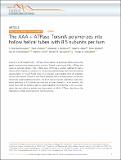| dc.contributor.author | Demircioglu, Fatma Esra | |
| dc.contributor.author | Zheng, Weili | |
| dc.contributor.author | McQuown, Alexander J. | |
| dc.contributor.author | Maier, Nolan K. | |
| dc.contributor.author | Watson, Nicki | |
| dc.contributor.author | Denic, Vladimir | |
| dc.contributor.author | Egelman, Edward H. | |
| dc.contributor.author | Schwartz, Thomas | |
| dc.contributor.author | Cheeseman, Iain M | |
| dc.date.accessioned | 2020-07-07T20:52:53Z | |
| dc.date.available | 2020-07-07T20:52:53Z | |
| dc.date.issued | 2019-07 | |
| dc.date.submitted | 2018-12 | |
| dc.identifier.issn | 2041-1723 | |
| dc.identifier.uri | https://hdl.handle.net/1721.1/126079 | |
| dc.description.abstract | TorsinA is an ER-resident AAA + ATPase, whose deletion of glutamate E303 results in the genetic neuromuscular disease primary dystonia. TorsinA is an unusual AAA + ATPase that needs an external activator. Also, it likely does not thread a peptide substrate through a narrow central channel, in contrast to its closest structural homologs. Here, we examined the oligomerization of TorsinA to get closer to a molecular understanding of its still enigmatic function. We observe TorsinA to form helical filaments, which we analyzed by cryo-electron microscopy using helical reconstruction. The 4.4 Å structure reveals long hollow tubes with a helical periodicity of 8.5 subunits per turn, and an inner channel of ~ 4 nm diameter. We further show that the protein is able to induce tubulation of membranes in vitro, an observation that may reflect an entirely new characteristic of AAA + ATPases. We discuss the implications of these observations for TorsinA function. | en_US |
| dc.description.sponsorship | National Institutes of Health (Grant AR065484) | en_US |
| dc.description.sponsorship | U.S. Army Medical Research Acquisition Activity Peer Reviewed Medical Research Program (Award W81XWH1810515) | en_US |
| dc.language.iso | en | |
| dc.publisher | Springer Science and Business Media LLC | en_US |
| dc.relation.isversionof | http://dx.doi.org/10.1038/s41467-019-11194-w | en_US |
| dc.rights | Creative Commons Attribution 4.0 International license | en_US |
| dc.rights.uri | https://creativecommons.org/licenses/by/4.0/ | en_US |
| dc.source | Nature | en_US |
| dc.title | The AAA + ATPase TorsinA polymerizes into hollow helical tubes with 8.5 subunits per turn | en_US |
| dc.type | Article | en_US |
| dc.identifier.citation | Demircioglu, F. Esra et al. "The AAA + ATPase TorsinA polymerizes into hollow helical tubes with 8.5 subunits per turn." Nature Communications 10, 1 (July 2019): 3262 © 2019 The Author(s) | en_US |
| dc.contributor.department | Massachusetts Institute of Technology. Department of Biology | en_US |
| dc.relation.journal | Nature Communications | en_US |
| dc.eprint.version | Final published version | en_US |
| dc.type.uri | http://purl.org/eprint/type/JournalArticle | en_US |
| eprint.status | http://purl.org/eprint/status/PeerReviewed | en_US |
| dc.date.updated | 2019-12-02T15:42:42Z | |
| dspace.date.submission | 2019-12-02T15:42:46Z | |
| mit.journal.volume | 10 | en_US |
| mit.journal.issue | 1 | en_US |
| mit.metadata.status | Complete | |
